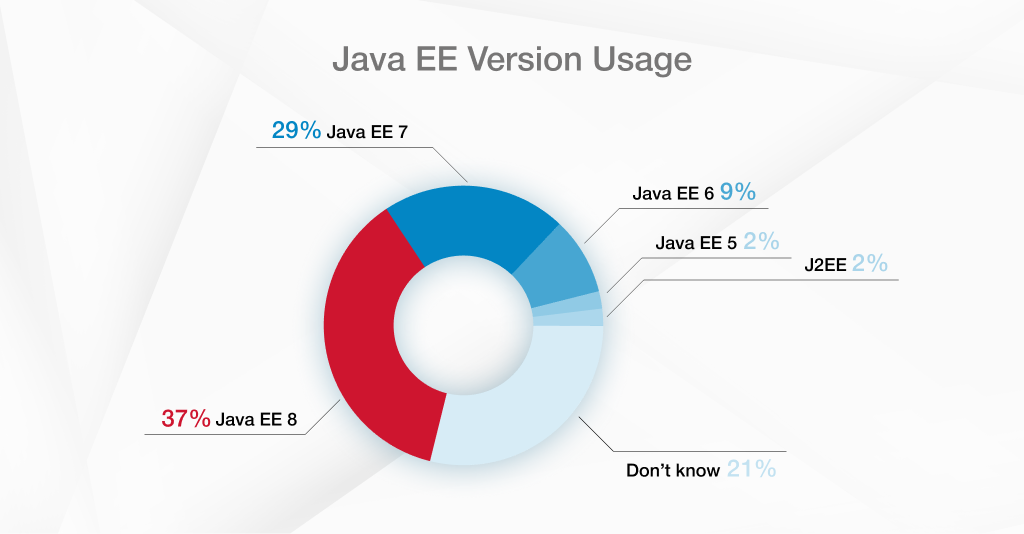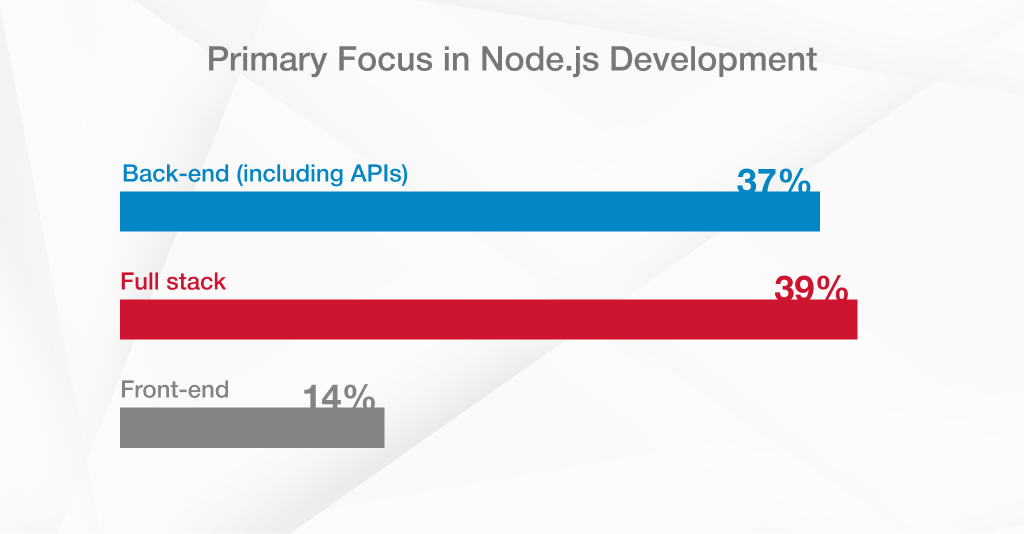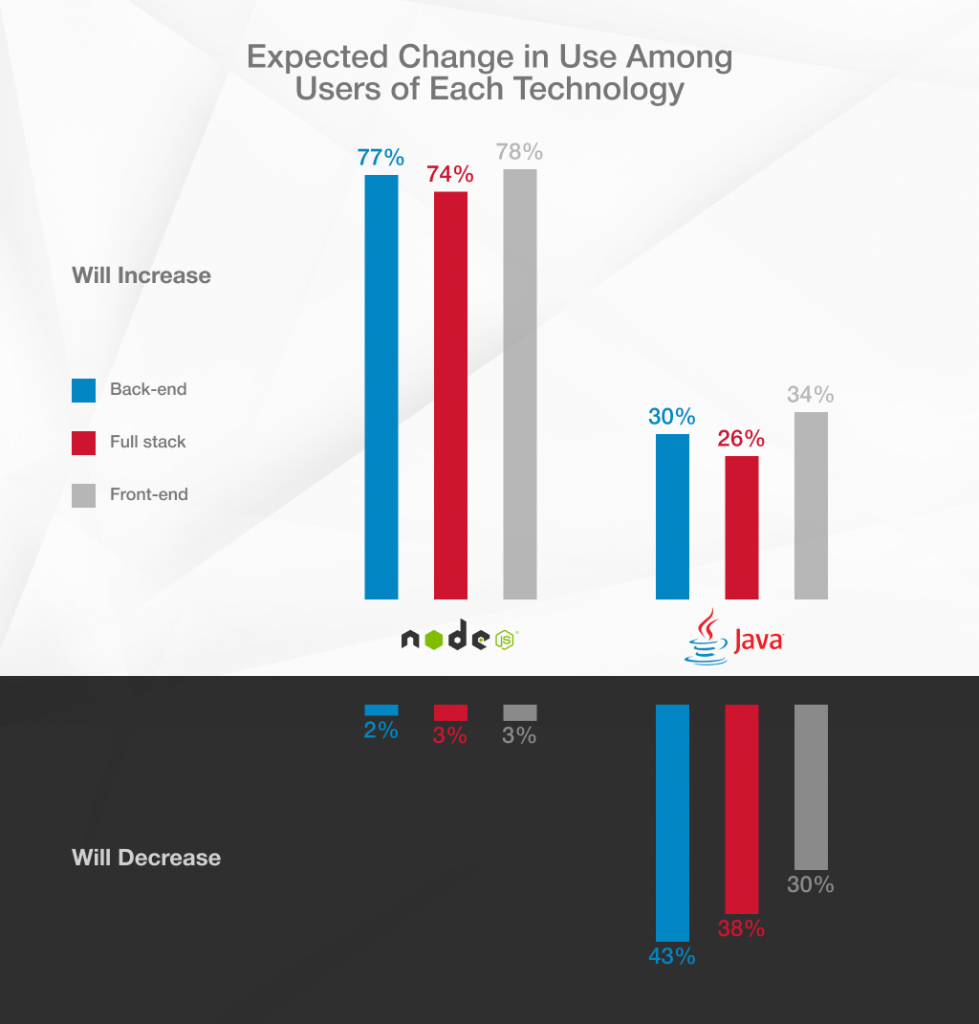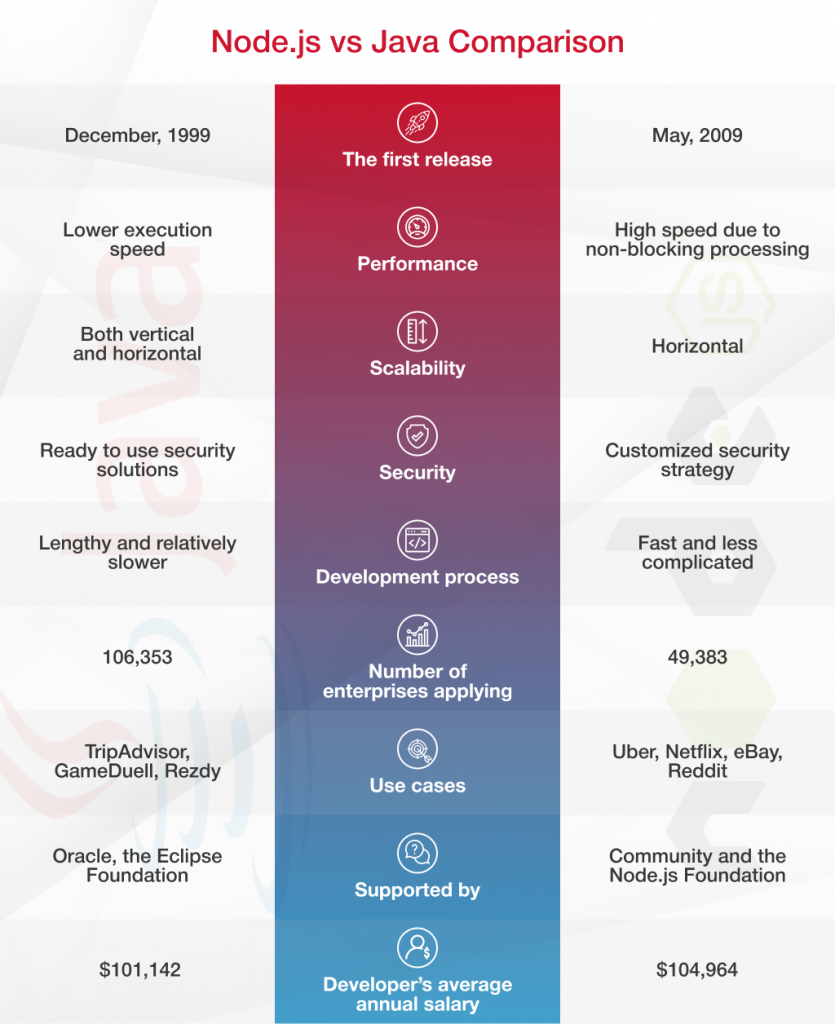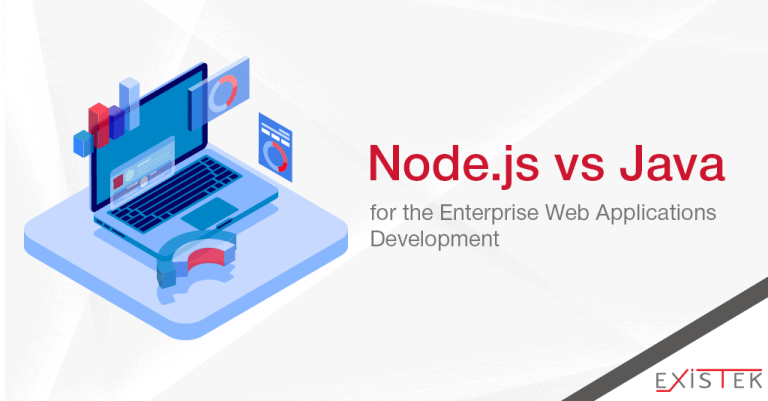
Updated: May 10, 2024
Published: March 18, 2020
Now, many companies started to evaluate or leverage Node.js as an alternative to Java because it has similar advantages such as microservices architecture while being more accessible and providing quicker development time. In this article, we’ll put Node.js vs Java to the direct comparison according to the main criteria required by business-oriented software and discover what are the strong and weak sides of each technology.
The development teams and business decision-makers have plenty of technologies available to create cloud-based solutions that can handle the significant workload, big user base and provide high security. Historically, this is the competition between Java, .NET, and PHP. All of them are very mature technologies released around 20 years ago that have been extended for web development with frameworks such as Java EE or ASP.NET. Java or Java SE is normally used for desktop applications development, APIs, and public products, so in the context of high-load web applications, we’ll be talking about frameworks designed and utilized specifically for these purposes, such as Java EE and Jakarta EE. In contrast, Node.js, with the first released 10 years ago, has been created as a pure web technology from the very beginning. Nevertheless, it has gained significant market share in both enterprise and public markets and managed to take its place as one of the primary options for new SaaS products and enterprise-responsive web applications for internal use.
List of the Content
- The market share and companies preferences: Node.js vs Java
- Java for enterprise web development
- Node.js development for enterprise web applications
- Node.js vs Java for the enterprise web applications development
- In conclusion
THE MARKET SHARE AND COMPANIES’ PREFERENCES: NODE.JS VS JAVA
First, let’s define what is meant by enterprise-grade web applications. It’s not necessary to use in-house software created by corporations for internal needs. This can be any SaaS solution that has a high number of users and sophisticated features. For example, the Ukrainian startup product Grammarly has 6.9 Million daily users despite having only 400+ employees. It is the cross-functional Chrome extension, web app, and desktop app that analyzes a user’s writing style and corrects mistakes, grammatical, stylistic, and spelling. Such number of users itself means that the company has impressive, extremely scalable back-end service and cloud infrastructure. In addition, the extensions and apps collect all the text input from the user’s computer and browser and send it to the server for processing. Thus, the service has access to the business and personal data of dozens of millions of people. Most companies would prohibit the use of such applications on the workstation, but the human is always the weakest part of any security system.
With this example, we can identify any web application that has a significant number of users, operates sensitive or confidential data, and has complex features as enterprise-grade software. The requirements are the same, and the efforts required to address them are the same.
To support such a high user count and ensure security Grammarly team uses a number of technologies, including Java EE, Ruby, Node.js, Python, MongoDB, MySQL, AWS, etc. If we focus on the back-end technologies, we’ll see the “usual suspects” Java and Node.js that are used on the server side for various back-end services. Big cloud solutions utilize a variety of technologies for different services depending on their advantages. For more details on Node.js vs Java, we’d address more precisely each of these server-side frameworks and explain how you can leverage them in the most effective way.
Java Enterprise Landscape
Java EE is one of the standard technologies in enterprise software development. This platform was initially created to reduce complexity by providing efficient tools to build, maintain and advance multi-tiered applications. With each new version, Java developers have the possibility to improve functionality and portability as well as increase overall productivity. In light of the latest news, Oracle announced that it had submitted Java EE to the Eclipse Foundation, and the name of the platform was rebranded as Jakarta EE. In fact, the developers’ choice of this technology hasn’t changed, and more than 66% of them stated that they would definitely stay with Java despite recent adjustments. Moreover, it is interesting to mention that a high percentage of developers are still using the previous versions of Java EE. They are quite satisfied with the provided features and don’t plan to migrate to other technology in the near future.
The Java EE version choice isn’t limited to one option. Developers state that they still use some previous versions and 21% of them don’t care which version to go with due to the great functionality they get.
Node.js Enterprise State
Node.js, as a JavaScript runtime, was built on Google Chrome’s V8 engine and opened new possibilities for web app development services. Consequently, it enabled using JavaScript not only for user-side scripting but server-side as well. Producing dynamic web pages is greatly facilitated by a number of libraries and developers’ tools. More than 75% of Node.js developers are engaged in back-end or full-stack development in comparison to 14% usage for front-end scripting. What is more, 47% of Node.js development is delivered for enterprise solutions and allows building the web application by using one programming language.
More than 75% of Node.js developers are engaged in back-end or full-stack development in comparison to 14% usage for front-end scripting.
As for the general market share of these technologies, we can combine the data on several important aspects. For example, 49,383 enterprises have used or recently switched to Node.js. At the same time, 106,353 companies state to use J2EE, one of the first versions of Java EE. Such companies as TripAdvisor, GameDuell, Rezdy, ICT Health favor Java in their tech stacks, whereas Uber, Netflix, eBay, Twitter, and Reddit apply Node.js. In terms of Java EE vs Node.js choice, Netflix proved their decision by the impressive ability to decrease the forty-minute startup time to less than a minute by switching to Node.js development. This tendency has considerably influenced the technologies’ popularity and predicts some changes in the near future. Thus, we recommend checking each technology’s advantages and drawbacks first and making the final Node.js vs Java choice according to the project needs and expectations.
The Node.js use for back-end development is going to increase by 77%, whereas Java – by 30%.
JAVA FOR ENTERPRISE WEB DEVELOPMENT
As long as we raise the Node.js vs Java question, we will start with defining the main aspects for each technology and what makes them strong competitors. Regarding Java web development, let’s consider the following:
APIs
Enterprise Java frameworks provide different sets of APIs to specify and organize the overall interaction between components. With each release, developers have access to some new options like Java API for JSON binding in Java EE 8. It has enabled converting Java objects from and to JSON messages via a provided binding level.
Design Patterns
In order to improve code quality and effectiveness of the architecture, developers could find solutions via design patterns. This approach is workable for both basic and advanced functionality as explored patterns focus on providing problem-solving alternatives. They usually become the connection between existing Java patterns and new concepts.
Modules
With the variety of Java modules, the development process is advanced by flexible, adaptable, and time-efficient solutions. For example, developers can easily access all Java interfaces, classes, and native libraries within resource adapter modules or find web and servlet class files in the web modules.
Microservices
Commonly, Java presents a set of specifications to create a monolithic enterprise web application. The approach is easier to deploy as it relies on creating one single unit; however, it is getting harder to compete with microservices. Thus, developers find a way to create microservices applying Java EE APIs in the app server like GlassFish.
Scalability
Due to the technical capabilities, Java executes different requests asynchronously without additional time on waiting to complete the previous ones. It allows the app to perform with some number of servers and support certain scalability. However, adding more servers isn’t always workable as it might decrease the performance speed.
Speed
The execution speed is measured by the processing time of input and output requests. Even though Java processes them in both blocking (one request at a time) and non-blocking manner (several requests at once). However, it still takes longer in comparison with Node.js. Managing the process flow requires additional attention to complexity.
Security
In terms of Java EE vs Node.js security, the great advantage of Java is the availability of all necessary features to secure enterprise applications out of the box. As a rule, developers integrate ready solutions like SSL encryption, authentication strategies, etc. However, it is usually long to learn them and complicated to customize.
Maintainability
Java development is known for its great code maintainability and computation efficiency. Developers also have access to a variety of libraries to raise development speed. Java IDEs and various debugging tools make the process faster and easier.
NODE.JS DEVELOPMENT FOR ENTERPRISE WEB APPLICATIONS
Node.js has easily gained its market share as it meets the real needs of enterprise web development. This approach is acknowledged due to the next aspects:
APIs
Codding consistency could be implemented through a variety of services, including APIs. It helps to facilitate performance and maintenance. For example, Node.js developers aren’t troubled with converting between JSON as these objects are easily exposed with the secure and simple REST APIs in Node.js.
Design Patterns
The design pattern deployment provides numerous benefits that enable excellent performance and reliability of the enterprise web application. It improves productivity via great structuring and the possibility of reusing the code. At the same time, developers favor the flexibility of JavaScript to implement decisions.
Modules
Node.js developers can deal with the set of functions available in the JavaScript libraries. In addition to this, there are a number of built-in modules. For instance, the built-in HTTP module allows the data transfer over HTTP, which serves as a connection between the server ports and the users.
Microservices
In order to build service-oriented architecture and improve modularity, developers structure the apps with the help of microservices. Single-threaded approaches in Node.js allows the server to respond without the blocking mechanism or the return data of the previous API. In fact, servers are capable of handling all the coming requests.
Scalability
This approach is known for its great horizontal scalability with the capability of adding more hardware. As for the vertical scalability, it practices single-threaded attributes; thus, it is recommended to use the cluster module for multi-core systems.
Speed
Node.js web applications are recognized for high speed due to non-blocking manners of processing both input and output requests. The fact that the tread could deal with several requests considerably increases the execution speed. In light of the Java EE vs Node.js comparison, such approach is the perfect choice for apps that need to handle massive operations.
Security
Node.js development is focused on mastering customized security strategies. It is also common to integrate specialized modules with the possibility of some configurations. This enables robust and secure development along with advancing existing approaches.
Maintainability
The main advantage is exceptionally fast development. Starting from the learning curve, it requires less time to begin here. Node.js developers acknowledge such aspects as code reusability, reactive style, excellent scalability, etc. Moreover, they can use JavaScript on both the server and client sides.
Curious to know more advantages of Node.js?
In the article, we’ve described how the backend development is organized with the help of Node.js. There you’ll find the pros and cons of this technology and some tips on hiring Node.js devs.
NODE.JS VS JAVA FOR THE ENTERPRISE WEB APPLICATIONS DEVELOPMENT
From one’s perspective, it might seem complicated to make Node.js vs Java choice. However, there is some practical advice on addressing this question in custom web application development. It is recommended to break down requirements and expectations according to the business and technical needs of the enterprise web application. Choosing up-to-date technology is as important as the ability to use resources efficiently.
When it comes to the technical side, it requires a comprehensive review of the technologies capabilities. We’ve already mentioned enough aspects for a valid comparison to be made. Yet let’s emphasize key factors to enlighten us about the Java vs Node.js backend comparison.
- Both technologies are an efficient solution that was successfully implemented in a number of projects.
- Furthermore, they offer a wide variety of tools and libraries.
- Regarding the learning curve, it is much faster to get acquainted with Node.js development and show high productivity.
- In terms of Node.js vs Java microservices, we have the definite winner – Node.js. It initially structures the app with microservices, whereas Java EE mainly focuses on the delivery of a monolithic web application.
- Java applications that can be scaled both vertically and horizontally in comparison to horizontal scalability of Node.js.
- As for Node.js vs Java REST API, Java has just introduced that option where Node.js developers greatly benefit from simple and secure REST APIS.
- The execution speed varies due to the difference in processing IO requests. Node.js is characterized by its faster performance.
- Last but not least is security; Java specialists follow the set of in-built security features when Node.js development can provide customized solutions.
As for the business aspects, it is vital to consider the market share, including business foresight, community support, frequency of updates, developers’ availability, etc.
The first difference is in the appearance and further maintenance of these technologies. From the very beginning, Java EE was pursuing the aim to advance enterprise functionality via extending its standard edition. Initially maintained by Oracle, it was submitted to Eclipse Foundation in 2017. Meanwhile, Node.js was advancing as the open-source JavaScript runtime supported by the Node.js Foundation and the developers’ community. Over the last few years, the choice for Node.js in enterprise web development shows the upward trends. It is caused not only by the efficiency of development but constant support and frequent updates. Regarding the last releases, Node.js was just updated on the 4th of March, 2020 whereas Java EE 8 was released on the 31st of August, 2017.
Another important aspect of Node.js vs Java choice is the availability and proficiency of developers. Even though it is reported that the overall number of Java developers is way higher, Node.js specialists are more in demand. According to the survey, the use of Node.js is expected to increase by 77%, and Java usage – only by 30%. On their part, employees stated to have the biggest gaps in hiring specialists that are proficient in the latest technologies like AngularJS, React, and Node.js. Such tendency also reflects on the average annual salaries – Node.js developer earns $104,964 and Java specialist – $101,142 in the US.
Now that you know more about these technologies, we hope you will be able to make the right Node.js vs Java choice. Covering your own requirements, make sure to benefit from the best advantages of the chosen technology stack.
IN CONCLUSION
The final choice is usually based on the number of advantages each technology can provide for your project. It is obvious that great security, scalability, performance, development efficiency, and maintenance services are the main requirements for enterprise web applications. Both businesses and developers are looking for the best option to implement project ideas and advance the provided services. Unless you combine the project needs and market requirements, it’ll be hard to choose. In other cases, there is always one great option within Node.js vs Java decision.
Have additional questions?
Consult professionals. Existek has been providing web development services since 2012. We’ve implemented a number of ideas into successful products. We’ll be glad to share our experience with you. Feel free to contact us via the chat widget on the right or visit our contact page for further assistance.
Frequently asked questions
What is the difference between Node.js and Java?
There are several aspects to consider when comparing Node.js and Java
Node.js uses non-blocking processing and thus has faster performance.
Java is known for both vertical and horizontal scalability, whereas Node.js offers only horizontal scalability.
Java is limited to in-built security solutions with no customized strategies.
The development process is faster and easier with Node.js.
Is Node.js replacing Java?
Node.js isn’t just a current market trend. It is showing all the promising signs of staying there for long. If we compare statistics on the expected change in use, Node.js is going to increase by 76%. Whereas, Java development is expecting an increase of only 31%. Moreover, the tendency to decrease is estimated at 3% for Node.js and 38% for Java.
What is Node.js good for?
Built around Javascript, Node.js enables full-stack development, ensuring great performance and speed of web applications. It is positioned among the best options for web development. Node.js is suitable for both enterprise and B2C application development.
Which is better: Node.js or Java?
The thing is, the needs of your business always drive the final choice. Each of these technologies has advantages suitable for particular projects. But it is evident that newer technology like Node.js will deliver better performance, excellent scalability and security, a faster development process, and easier maintenance.

